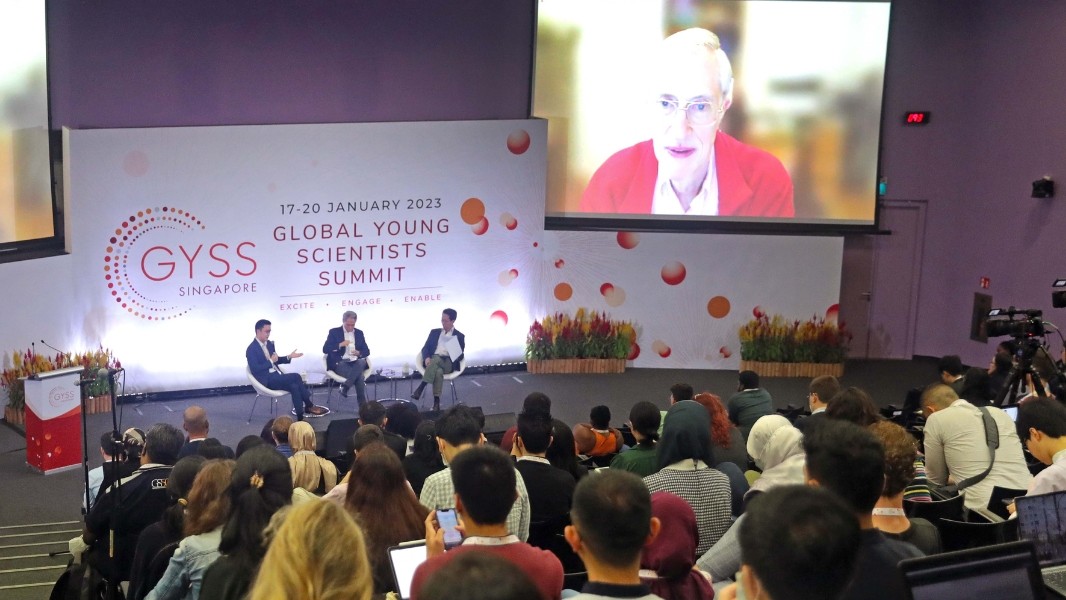The Global Young Scientists Summit: How to make the leap from academia to industry
Tue, 03/14/2023 - 12:00
Is academia the final pit-stop in the scientific career pipeline? Not necessarily so, according to panellists at the Global Young Scientists Summit held earlier this year.
The panel, called “Careers Beyond Academia”, featured startup founders Dr Shi Xu and Dr Zhou Lihan, and Nobel Prize winner Dr John Mathers. They spoke about how academics can make the leap from Institutes of Higher Learning into industry and how to navigate potential pitfalls while drawing from their own personal experiences. The session was moderated by Dr Lim Jui, SGInnovate’s Chief Executive Officer (CEO).
Leaving academia does not spell an end to advancing science
Many young scientists worry that entering non-academic environments means that they are no longer advancing science. But doing good and making money are not mutually exclusive, assured the panellists.
Being in a business environment can be “a natural step from discovery to impact”, said Dr Zhou, CEO and Co-founder of biotech firm MiRXES, and former research scientist at the Agency for Science, Technology and Research (A*STAR). His company creates RNA-powered blood tests for early detection of diseases like gastric cancer.
Dr Shi, Founder and Executive Chairman of Nanofilm Technologies International, added that it is a matter of perspective. Scientists should view the “shift” as making their ideas work in the real world, noted the former associate professor at Nanyang Technological University.
Panellists Dr Zhou Lihan (left), Dr Shi Xu (middle) with moderator Dr Lim Jui (right).
“The internal driving force as a scientist is always the desire to make an impact and see your technology being put to practical use. You can still do that in a company. But you need to select the area that you have breakthroughs (in),” he added. In his case, Nanofilm is the leading provider of nanotech solutions in Asia in biomedical and automotive industries.
Applying technology to solve real-life problems was Dr Mather’s greatest motivating factor too. Joining virtually from Maryland, the winner of the 2006 Nobel Prize for Physics and Senior Astrophysicist at NASA’s Goddard Space Flight Centre said: “One of my eureka moments was just knowing that I knew how to solve a problem that people want solved.”
Still, there is room for academia and industry to work together to deepen research. Panellists noted that corporate laboratories in Singapore universities have helped facilitate closer cooperation between the two entities – something that Nanofilm has benefited from.
“(We can) work closely with academics, take advantage of multi-disciplinary possibilities and work on raising TRL (Technology Readiness Levels). It is a very natural collaboration,” he said.
Breaking into business is challenging but not impossible
The right mindset – delivering impact – is more important than experience in making a successful switch. And the key to delivering impact, they stressed, is understanding both people and market needs. The process is not unlike a science experiment: Identify a problem, research, construct a hypothesis and test it. If it works, sell it.
Understanding the market involves scoping out competitors and competing products. Some products are supplements to bigger corporations, but others can allow businesses to stand on their own.
Dr John Mather (on screen) dialled in from Maryland, USA,
where Nasa’s Goddard Space Flight Centre is located.
“Ask yourself what makes your product unique and how it’ll serve your market,” said Dr Shi. His company’s wear-resistant carbon coating, for example, is found in a slew of products from auto parts to smartphones.
Dr Mather also noted that the decision to leave academia boils down to practical concerns. In university settings, relative to large agencies like NASA, scientists do not typically have direct access to resources and funding.
“If I’d stayed in academia, I might not have been able to take credit for (the Cosmic Background Explorer),” he said, referring to a NASA satellite he invented that can take precise measurements of microwave radiation in the universe.
More importantly, aspiring scientists should take failure in stride. Just like in the lab, getting things right in the corporate world involves trial and error. Dr Zhou recalled making 600 pitches after spinning off from A*STAR to secure his first official sale.
Getting industry-ready requires empathy
Students in the audience asked how to identify if their technology is ready for commercialisation. This is where scientists must put themselves in the shoes of the layman.
There were many questions from students in the crowd seeking advice from panellists about the optimal time to take technology out of the lab for commercialisation.
“We need to start thinking: How is my discovery relevant to Mr John on the street?” Dr Zhou elaborated.
There is also the need to acquaint yourself with the nitty-gritty of business, including the basics of accounting and finance, and more importantly, assembling a good team to rely on.
“In job interviews, I always ask, ‘How is MiRXES relevant to you?’, not the other way around. If this individual’s interests align with the company’s interests, then it’s an easy path,” added Dr Zhou.
This shift in mindset also makes it easier to build rapport in the industry. In short, as Dr Shi put simply, “Strive for win-win situations.”
Trending Posts
- Keeping satellites safe: How CYSAT Asia 2026 is tackling space cybersecurity
- The future of fusion energy: What will it take to bring the power of the stars to earth?
- How an aerospace engineer charted a path to quantum technology
- Scaling nanomaterials is challenging — Meet the startup with a hybrid solution
- Surveying Singapore's early-stage emerging tech startup landscape






